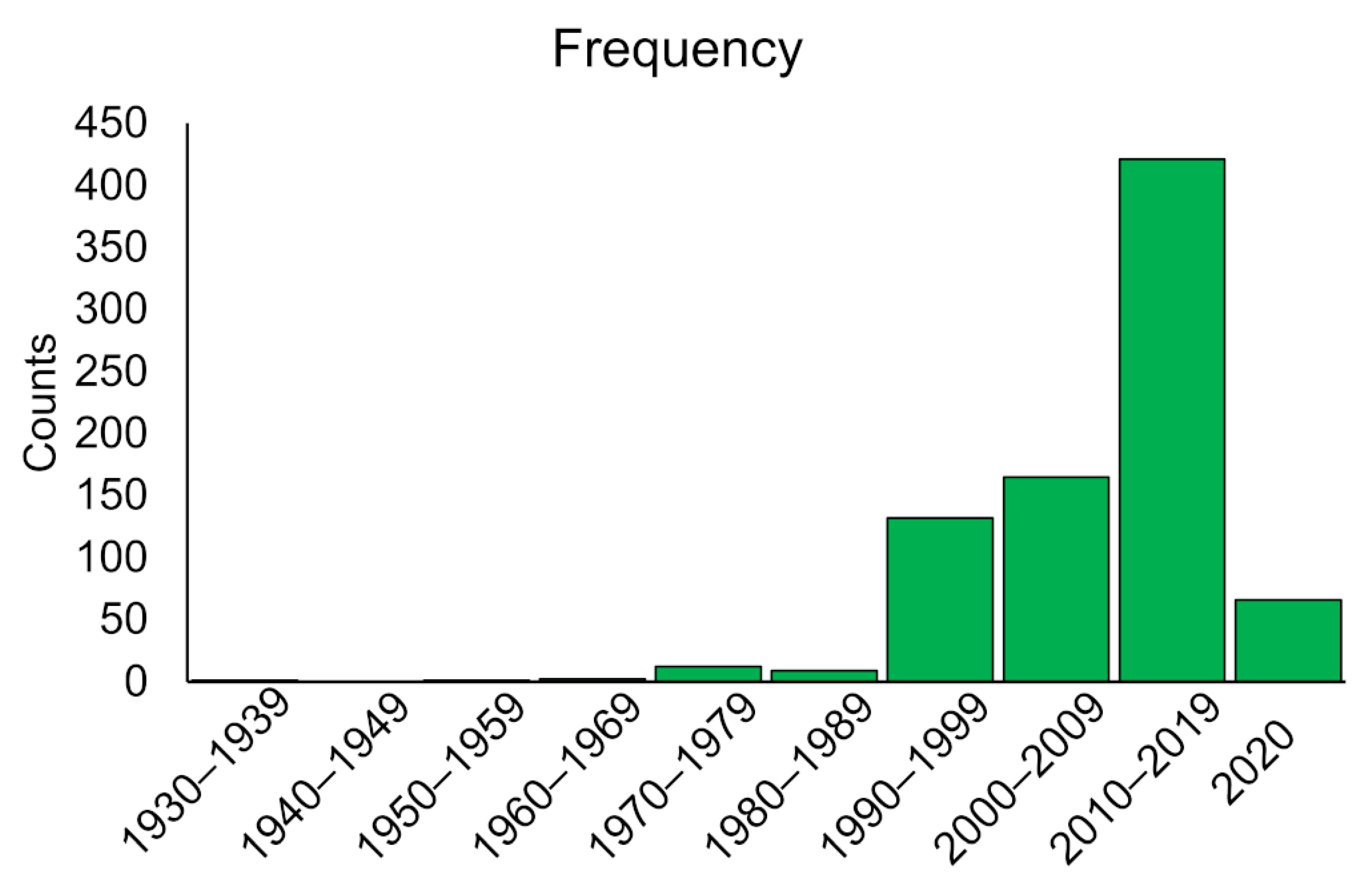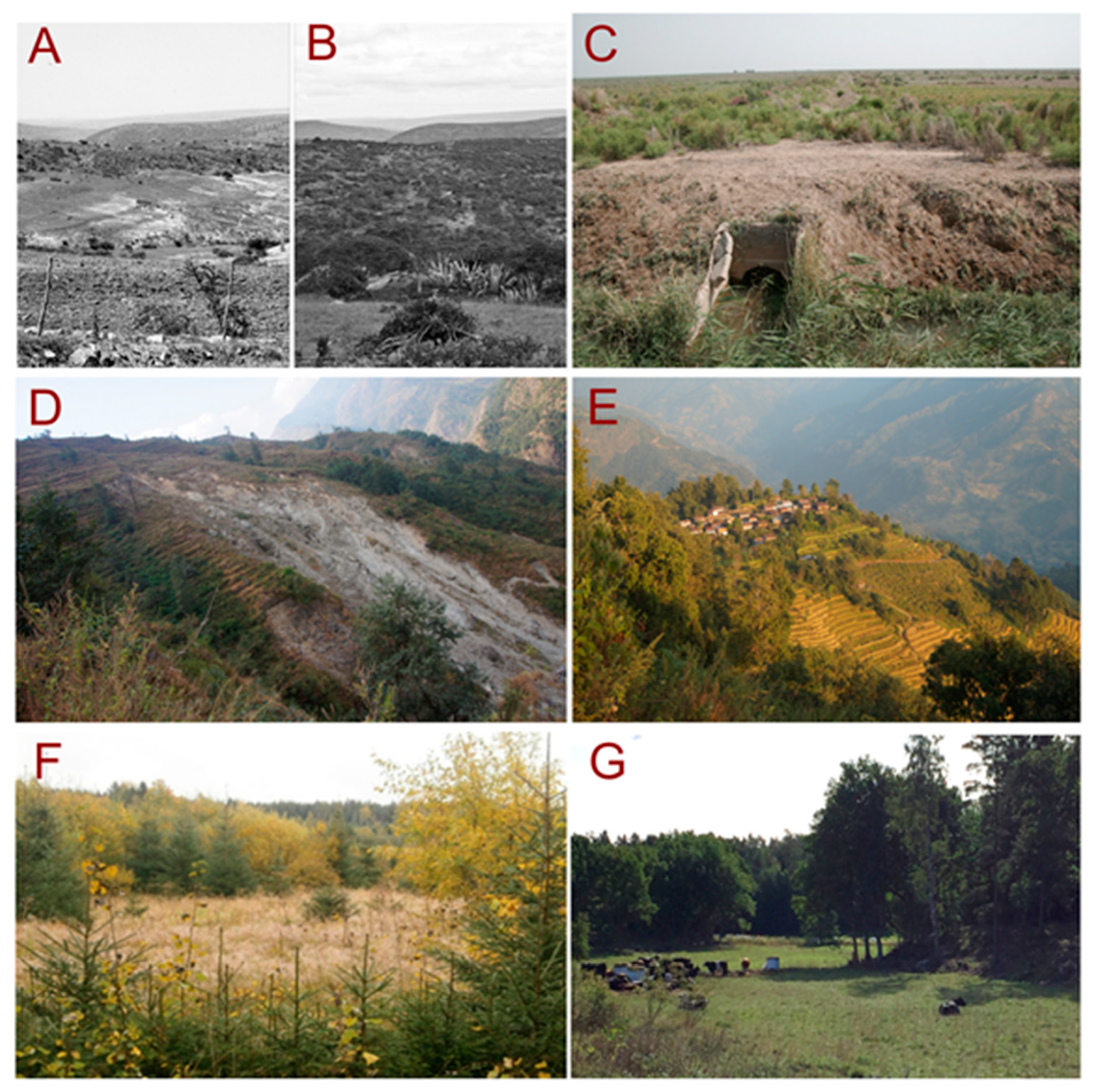Unraveling the Diversity of Trajectories and Drivers of Global Agricultural Land Abandonment
The Diversity of Definitions of Agricultural Land Abandonment
The Diversity of Approaches to Document the Patterns of Agricultural Land Abandonment
Complex Driving Mechanisms That Result in Agricultural Land Abandonment
Trade-Offs between Keeping Agricultural Lands Idle and Alternative Land Uses
Key Findings and Ways Forward
A Short Summary of Studies Published in the Special Issue
Funding
Institutional Review Board Statement
Informed Consent Statement
Conflicts of Interest
References
- Huang, Y.; Li, F.; Xie, H. A Scientometrics Review on Farmland Abandonment Research. Land 2020, 9, 263. [Google Scholar] [CrossRef]
- Queiroz, C.; Beilin, R.; Folke, C.; Lindborg, R. Farmland Abandonment: Threat or Opportunity for Biodiversity Conservation? A Global Review. Front. Ecol. Environ. 2014, 12, 288–296. [Google Scholar] [CrossRef]
- Renwick, A.; Jansson, T.; Verburg, P.H.; Revoredo-Giha, C.; Britz, W.; Gocht, A.; McCracken, D. Policy Reform and Agricultural Land Abandonment in the EU. Land Use Policy 2013, 30, 446–457. [Google Scholar] [CrossRef]
- Chaudhary, S.; Wang, Y.; Dixit, A.M.; Khanal, N.R.; Xu, P.; Fu, B.; Yan, K.; Liu, Q.; Lu, Y.; Li, M. A Synopsis of Farmland Abandonment and Its Driving Factors in Nepal. Land 2020, 9, 84. [Google Scholar] [CrossRef]
- Holcomb, J.P.; Frederic, P.; Brunn, S.D. A Visual Typology of Abandonment in Rural America: From End-of-Life to Treading Water, Recycling, Renaissance, and Revival. Land 2020, 9, 94. [Google Scholar] [CrossRef]
- Pazúr, R.; Lieskovský, J.; Bürgi, M.; Müller, D.; Lieskovský, T.; Zhang, Z.; Prishchepov, A.V. Abandonment and Recultivation of Agricultural Lands in Slovakia—Patterns and Determinants from the Past to the Future. Land 2020, 9, 316. [Google Scholar] [CrossRef]
- Kolecka, N.; Kozak, J. Wall-to-Wall Parcel-Level Mapping of Agricultural Land Abandonment in the Polish Carpathians. Land 2019, 8, 129. [Google Scholar] [CrossRef]
- Huang, X.; Ziniti, B.; Torbick, N. Assessing Conflict Driven Food Security in Rakhine, Myanmar with Multisource Imagery. Land 2019, 8, 95. [Google Scholar] [CrossRef]
- Kc, B.; Race, D. Outmigration and Land-Use Change: A Case Study from the Middle Hills of Nepal. Land 2019, 9, 2. [Google Scholar] [CrossRef]
- Chaudhary, S.; Wang, Y.; Dixit, A.M.; Khanal, N.R.; Xu, P.; Fu, B.; Yan, K.; Liu, Q.; Lu, Y.; Li, M. Spatiotemporal Degradation of Abandoned Farmland and Associated Eco-Environmental Risks in the High Mountains of the Nepalese Himalayas. Land 2019, 9, 1. [Google Scholar] [CrossRef]
- Blair, D.; Shackleton, C.; Mograbi, P. Cropland Abandonment in South African Smallholder Communal Lands: Land Cover Change (1950–2010) and Farmer Perceptions of Contributing Factors. Land 2018, 7, 121. [Google Scholar] [CrossRef]
- Du, J.; Zeng, M.; Xie, Z.; Wang, S. Power of Agricultural Credit in Farmland Abandonment: Evidence from Rural China. Land 2019, 8, 184. [Google Scholar] [CrossRef]
- Kumm, K.-I.; Hessle, A. Economic Comparison between Pasture-Based Beef Production and Afforestation of Abandoned Land in Swedish Forest Districts. Land 2020, 9, 42. [Google Scholar] [CrossRef]
- Kuntz, K.; Beaudry, F.; Porter, K. Farmers’ Perceptions of Agricultural Land Abandonment in Rural Western New York State. Land 2018, 7, 128. [Google Scholar] [CrossRef]
- Van Vliet, J.; de Groot, H.L.F.; Rietveld, P.; Verburg, P.H. Manifestations and Underlying Drivers of Agricultural Land Use Change in Europe. Landsc. Urban Plan. 2015, 133, 24–36. [Google Scholar] [CrossRef]
- Hatna, E.; Bakker, M.M. Abandonment and Expansion of Arable Land in Europe. Ecosystems 2011, 14, 720–731. [Google Scholar] [CrossRef]
- Prishchepov, A.V.; Müller, D.; Dubinin, M.; Baumann, M.; Radeloff, V.C. Determinants of Agricultural Land Abandonment in Post-Soviet European Russia. Land Use Policy 2013, 30, 873–884. [Google Scholar] [CrossRef]
- Schierhorn, F.; Müller, D.; Beringer, T.; Prishchepov, A.V.; Kuemmerle, T.; Balmann, A. Post-Soviet Cropland Abandonment and Carbon Sequestration in European Russia, Ukraine, and Belarus. Glob. Biogeochem. Cycles 2013, 27, 1175–1185. [Google Scholar] [CrossRef]
- Löw, F.; Prishchepov, A.; Waldner, F.; Dubovyk, O.; Akramkhanov, A.; Biradar, C.; Lamers, J. Mapping Cropland Abandonment in the Aral Sea Basin with MODIS Time Series. Remote Sens. 2018, 10, 159. [Google Scholar] [CrossRef]
- Shackleton, C.M.; Mograbi, P.J.; Drimie, S.; Fay, D.; Hebinck, P.; Hoffman, M.T.; Maciejewski, K.; Twine, W. Deactivation of Field Cultivation in Communal Areas of South Africa: Patterns, Drivers and Socio-Economic and Ecological Consequences. Land Use Policy 2019, 82, 686–699. [Google Scholar] [CrossRef]
- Xie, H.; Wang, P.; Yao, G. Exploring the Dynamic Mechanisms of Farmland Abandonment Based on a Spatially Explicit Economic Model for Environmental Sustainability: A Case Study in Jiangxi Province, China. Sustainability 2014, 6, 1260. [Google Scholar] [CrossRef]
- Davis, M.A.; Reich, P.B.; Knoll, M.J.B.; Dooley, L.; Hundtoft, M.; Attleson, I. Elevated Atmospheric CO2: A Nurse Plant Substitute for Oak Seedlings Establishing in Old Fields. Glob. Chang. Biol. 2007, 13, 2308–2316. [Google Scholar] [CrossRef]
- Christensen, V.G.; Lee, K.E.; McLees, J.M.; Niemela, S.L. Relations between Retired Agricultural Land, Water Quality, and Aquatic-Community Health, Minnesota River Basin. J. Environ. Qual. 2012, 41, 1459–1472. [Google Scholar] [CrossRef] [PubMed]
- Kalinina, O.; Goryachkin, S.V.; Karavaeva, N.A.; Lyuri, D.I.; Najdenko, L.; Giani, L. Self-Restoration of Post-Agrogenic Sandy Soils in the Southern Taiga of Russia: Soil Development, Nutrient Status, and Carbon Dynamics. Geoderma 2009, 152, 35–42. [Google Scholar] [CrossRef]
- Kurganova, I.; Lopes de Gerenyu, V.; Kuzyakov, Y. Large-Scale Carbon Sequestration in Post-Agrogenic Ecosystems in Russia and Kazakhstan. Catena 2015, 133, 461–466. [Google Scholar] [CrossRef]
- FAOSTAT Food and Agriculture Organization of the United Nations. FAOSTAT Database. Trade. Crops and Livestock Products. Available online: http://faostat3.fao.org/browse/T/TP/E (accessed on 20 January 2020).
- Prishchepov, A.V. Agricultural Land Abandonment. In Environmental Science; Oxford Bibliographies: Oxford, UK, 2020. [Google Scholar] [CrossRef]
- Hebinck, P.; Mtati, N.; Shackleton, C. More than Just Fields: Reframing Deagrarianisation in Landscapes and Livelihoods. J. Rural Stud. 2018, 61, 323–334. [Google Scholar] [CrossRef]
- UN FAO. The Role of Agriculture and Rural Development in Revitalizing Abandoned/Depopulated Areas; Food and Agriculture Organization of the United Nations: Rome, Italy, 2006; p. 24. [Google Scholar]
- UN FAO. FAOSTAT, Methods & Standards [WWW Document]; Food and Agriculture Organization of the United Nations: Rome, Italy, 2016; p. 3. [Google Scholar]
- Grădinaru, S.R.; Iojă, C.I.; Vânău, G.O.; Onose, D.A. Multi-Dimensionality of Land Transformations: From Definition to Perspectives on Land Abandonment. Carpathian J. Earth Environ. Sci. 2020, 15, 167–177. [Google Scholar] [CrossRef]
- Geist, H.J.; Lambin, E.F. Proximate Causes and Underlying Driving Forces of Tropical Deforestation. Bioscience 2002, 52, 143–150. [Google Scholar] [CrossRef]
- Baumann, M.; Kuemmerle, T. The Impacts of Warfare and Armed Conflict on Land Systems. J. Land Use Sci. 2016, 11, 672–688. [Google Scholar] [CrossRef]
- Maystadt, J.-F.; Mueller, V.; Van Den Hoek, J.; van Weezel, S. Vegetation Changes Attributable to Refugees in Africa Coincide with Agricultural Deforestation. Environ. Res. Lett. 2020, 15, 044008. [Google Scholar] [CrossRef]
- Eklund, L.; Degerald, M.; Brandt, M.; Prishchepov, A.V.; Pilesjö, P. How Conflict Affects Land Use: Agricultural Activity in Areas Seized by the Islamic State. Environ. Res. Lett. 2017, 12, 054004. [Google Scholar] [CrossRef]
- Yin, H.; Butsic, V.; Buchner, J.; Kuemmerle, T.; Prishchepov, A.V.; Baumann, M.; Bragina, E.V.; Sayadyan, H.; Radeloff, V.C. Agricultural Abandonment and Re-Cultivation during and after the Chechen Wars in the Northern Caucasus. Glob. Environ. Chang. 2019, 55, 149–159. [Google Scholar] [CrossRef]
- Hostert, P.; Kuemmerle, T.; Prishchepov, A.; Sieber, A.; Lambin, E.F.; Radeloff, V.C. Rapid Land Use Change after Socio-Economic Disturbances: The Collapse of the Soviet Union versus Chernobyl. Environ. Res. Lett. 2011, 6, 045201. [Google Scholar] [CrossRef]
- Sekizawa, R.; Ichii, K.; Kondo, M. Satellite-Based Detection of Evacuation-Induced Land Cover Changes Following the Fukushima Daiichi Nuclear Disaster. Remote Sens. Lett. 2015, 6, 824–833. [Google Scholar] [CrossRef]
- Prishchepov, A.V.; Radeloff, V.C.; Baumann, M.; Kuemmerle, T.; Müller, D. Effects of Institutional Changes on Land Use: Agricultural Land Abandonment during the Transition from State-Command to Market-Driven Economies in Post-Soviet Eastern Europe. Environ. Res. Lett. 2012, 7, 024021. [Google Scholar] [CrossRef]
- Munroe, D.K.; van Berkel, D.B.; Verburg, P.H.; Olson, J.L. Alternative Trajectories of Land Abandonment: Causes, Consequences and Research Challenges. Curr. Opin. Environ. Sustain. 2013, 5, 471–476. [Google Scholar] [CrossRef]



Publisher’s Note: MDPI stays neutral with regard to jurisdictional claims in published maps and institutional affiliations. |
© 2021 by the authors. Licensee MDPI, Basel, Switzerland. This article is an open access article distributed under the terms and conditions of the Creative Commons Attribution (CC BY) license (http://creativecommons.org/licenses/by/4.0/).
Share and Cite
Prishchepov, A.V.; Schierhorn, F.; Löw, F. Unraveling the Diversity of Trajectories and Drivers of Global Agricultural Land Abandonment. Land 2021, 10, 97. https://doi.org/10.3390/land10020097
Prishchepov AV, Schierhorn F, Löw F. Unraveling the Diversity of Trajectories and Drivers of Global Agricultural Land Abandonment. Land. 2021; 10(2):97. https://doi.org/10.3390/land10020097
Chicago/Turabian StylePrishchepov, Alexander V., Florian Schierhorn, and Fabian Löw. 2021. "Unraveling the Diversity of Trajectories and Drivers of Global Agricultural Land Abandonment" Land 10, no. 2: 97. https://doi.org/10.3390/land10020097
APA StylePrishchepov, A. V., Schierhorn, F., & Löw, F. (2021). Unraveling the Diversity of Trajectories and Drivers of Global Agricultural Land Abandonment. Land, 10(2), 97. https://doi.org/10.3390/land10020097







